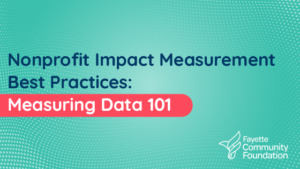Nonprofit Impact Measurement Best Practices: Measuring Data 101
 Do you want to grow your fundraising and grant income in 2022? Great! The best way to do that is to tell your nonprofit’s story using data. Now, we know what you might be thinking… DATA!? However, we are here to help you determine what data to use for your annual report, annual meeting, infographics, social media posts, and more. As a nonprofit leader you know grantors, donors, and supporters expect to see the impact. Yet, the challenge is often figuring out what data should be collected. We are here to help! We have created your nonprofit impact measurement best practices guide.
Do you want to grow your fundraising and grant income in 2022? Great! The best way to do that is to tell your nonprofit’s story using data. Now, we know what you might be thinking… DATA!? However, we are here to help you determine what data to use for your annual report, annual meeting, infographics, social media posts, and more. As a nonprofit leader you know grantors, donors, and supporters expect to see the impact. Yet, the challenge is often figuring out what data should be collected. We are here to help! We have created your nonprofit impact measurement best practices guide.
There is often so much confusion about properly reporting your organization’s impact. If we know anything about nonprofits, it’s hard to show impact purely through financial reports. The funding coming and going does not tell the story of impact. Nonprofit financial reports don’t always paint the entire picture because we can’t easily measure social and emotional impact. Continue reading to learn more about reporting the data that help you tell a story.
Keep It Simple
Don’t stress about tracking all of the data. We know that recording extensive amounts of data for a small organization is time-consuming. At larger organizations, they have whole teams dedicated to data recording and analysis. Obviously, if you have a much smaller team with fewer resources, this means you need to prioritize the data you will collect. Tracking every piece of data isn’t necessary. Instead, focus on what will show your organization’s true impact.
3 Categories Of Nonprofit Impact Measurement
There are so many data points that you can record, but we found there are three categories of nonprofit impact measurement that you should focus on: WHAT, HOW and WHO. Keeping it simple boils down to these three questions:
- What did we do as an organization?
- How well did we do it?
- Who did we serve?
Answering these questions begins to narrow down what metrics your organization should track and report out. So, let’s break these down by question.
What Did We Do As An Organization?
What did we do as an organization? This question gets to the heart of what your organization offers to those you serve. Consider activities, programs, and services. For example, you might list the programs offered in 2022. This is your first data point; did you offer four programs last year and two programs the year before? It shows the organization has doubled its programs in one year. Here’s a list of metrics to potentially track:
- Number of programs/services offered
- Number of products delivered/provided
- How many attendants
- Volunteer data
 Volunteers
Volunteers
Volunteers are often an essential part of delivering on your promise to the community. Therefore, it is vital to show the impact and dedication of volunteers. Tracking information about volunteers shows that your organization has the support of the community. Here are a few volunteer metrics you can consider tracking:
- How often do volunteers come back?
- How many volunteers became donors?
- Are volunteers showing up at events?
For many small organizations, there may be only a handful of volunteers throughout the year. However, if there are so many volunteers you can’t track them easily on your own, we suggest purchasing software to track donors and volunteers. Tracking software is something that would significantly improve your organization’s ability to track data, but only if it is something your team will be able to use and implement effectively.
How Well Did We Do?
How well did we do? This question concerns the quality of the activities, programs, and services. The data tells the story of how well you are operating the programs or services. Here’s a list of metrics to track quality and performance. Consider the following:
- % of completion (participants or target population that completed your service offering)
- rate of turnover (staff or participants)
- % of staff who completed training
- donor relationships data
 Fundraising and Donor Relationships
Fundraising and Donor Relationships
Fundraising is one of the most critical pieces of a thriving nonprofit. Outside of the financial contribution, what else can you learn about your donors and grant givers?
- How many donors are giving year after year?
- Did you have a growth in your number of donors?
- How many grant applications did you have accepted?
Now you may be asking how you track this data? We would suggest keeping this information wherever you track your donors. For example, if you track donors through a Microsoft Excel spreadsheet, make the document do the work for you.
Who Did We Serve?
Who do we serve? This is the most critical question the organization can ask and report on. It answers the question of your organization’s tangible impact on your target population and community. Clearly define who was positively impacted by your work. Remember, it can be more than just the population you directly serve, so don’t forget stakeholders and program partners. Use online surveys like Google Forms or Survey Monkey to measure your impact. Surveys are a great way to collect anonymous yet meaningful data. Here’s a list of metrics to consider tracking:
- % or # of people satisfied with program or service provided
- return on investment
- % of who accomplished {fill in the blank} after a period of time (i.e., % of free technical certifications participants who’ve been placed in a full-time job using that technical certificate)
Resources for Data Measurement
So far, we’ve shared a lot about internal nonprofit impact measurement and organization-specific impact, what we call micro-level. However, your nonprofit may also be focused on a community level or macro-level data. Finding macro-level statistics can be like finding a needle in a haystack, especially when you don’t know where to start, which is why we found the perfect sites for you to begin with.
One final suggestion for all nonprofits is to pull data for Fayette County and Indiana. Make use of data that has already been collected. Many organizations are compiling quality data about your state and county. Instead of gathering that information yourself, which is frankly not possible for most of us, find reliable sources to pull information from to help you show your impact. Remember, your organization should be collecting micro-level/internal data and macro-level/community level impact data to tell your organization’s story.
Get More Information
We hope that our tips on nonprofit impact measurement help you. If you are looking to level up your nonprofit, we have more tips to help you along the way. For more nonprofit information, check out our blog, where we have dedicated a blog each month to support our local nonprofits. If you want to stay updated with everything that is happening at the Fayette Community Foundation, sign up for our nonprofit newsletter.